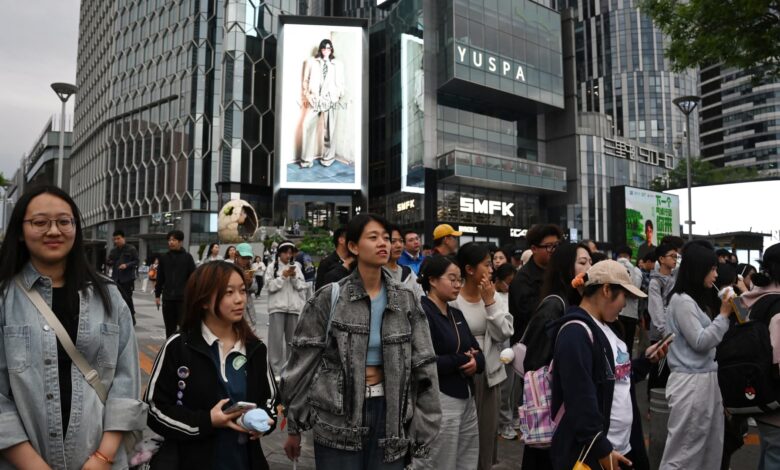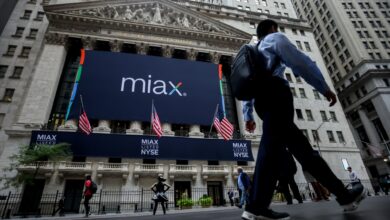Big Chinese companies like Alibaba show that AI-powered ads are giving shopping a boost

Downtown Beijing on May 2, 2025.
Greg Baker | Afp | Getty Images
BEIJING — Alibaba, Tencent and JD.com reported earnings this week that not only reflected improving Chinese consumer spending, but also the growing benefits of artificial intelligence in advertising.
E-commerce giant Alibaba said late Thursday its Taobao and Tmall group sales rose by 9% year on year to 101.37 billion yuan ($13.97 billion) for the three months ended March 31. That’s above the 97.94 billion yuan predicted by a FactSet analyst poll, and the quarterly growth figure was well above the 3% segment increase for the 12-month period ending March 31.
“The e-commerce and ad revenues were positive surprises as there were expectations tariffs would affect consumer behavior,” Kai Wang, Asia equity market strategist at Morningstar, said in an email regarding the three companies’ earnings results.
It’s important to note the earnings releases cover only the period before U.S.-China tensions escalated in April with new tariffs of more than 100% on products from both countries — an effective trade embargo. The two countries issued a rare joint statement Monday announcing a 90-day reduction in most of the recently added tariffs.
The U.S.-China trade dispute since April has negatively affected consumption to some extent, given the increased uncertainty for small and medium-sized businesses, Charlie Chen, managing director and head of Asia research at China Renaissance Securities, said Friday. He expects that as trade tensions ease, consumption will rise.
But despite lackluster consumption overall, sales of certain electronics and home appliances have done well since last year thanks to China’s trade-in subsidies for supporting such consumer spending.
JD.com on Tuesday said its sales of for that category surged by 17% from a year ago. Overall, the e-commerce company reported a 16.3% increase in revenue from its retail business to 263.85 billion yuan in the three months ended March 31. That was better than the 226.84 billion yuan in retail segment sales predicted by a FactSet poll.
On Wednesday, Tencent said its “fintech and business services” segment, a proxy for consumer-related business transactions, reported a 5% year-on-year revenue increase to 54.9 billion yuan in the first quarter.
While Nomura analysts said that segment revenue growth was in line with estimates, they pointed out in a note that “Tencent ads was a big outperformer in the Chinese ads industry despite the challenging macro environment.”
Tencent’s marketing services revenue surged by 20% to 31.9 billion yuan, helped by “robust advertiser demand” for short videos and other content inside its WeChat social media app. Tencent noted “ongoing AI upgrades” to its advertising platform.
AI is boosting ads
AI is helping Tencent lift its click-through rates — a measure of success for online ads — to nearly 3%, company management said on an earnings call Wednesday, according to a FactSet transcript. That’s up sharply from a 0.1% click-through rate for banner ads historically, and around 1% for feed ads, the company said.
Combined monthly average users for WeChat, known as Weixin in China, topped 1.4 billion in the first quarter for the first time. The app offers one of two major mobile payment systems used in mainland China.
Many coffee shops and online retailers also use mini-apps in WeChat for customers to place orders. Tencent said Thursday that its e-commerce operations had grown so large it was now a new unit within WeChat.
“AI ads improve efficiency and algorithm, which should translate into better targeting towards consumers even if macro conditions are not optimal,” Morningstar’s Wang said. “It is still a bit early to quantify how much incremental benefit AI ads bring compared to non-AI ads, but we have seen some monetization from AI-driven ads.”
JD said its marketing revenues climbed by 15.7% to 22.32 billion yuan for the quarter, also partly attributing that rise to AI tools.
On an earnings call Tuesday, JD management said its advertising research and development team is using large language models to improve ad conversion rates and accelerate ad revenue growth. The company added it is implementing AI tools that enable merchants to “execute complex ad campaigns” with a simple command.
Advertisers have long sought ways to target ads at the consumers most likely to make a purchase.
On Wednesday, YouTube announced that advertisers can use Google’s Gemini AI model to target ads to viewers when they are most engaged with a video.
Alibaba noted that marketing revenue, which it calls “customer management,” grew 12% year on year to nearly $10 billion thanks in part to increased use of the company’s AI tool for boosting merchants’ marketing efficiency, Quanzhantui.
Uncertain outlook
However, Alibaba’s overall profit was only about half of what analysts had predicted, sending shares down by nearly 7.6% in subsequent the U.S. trading session.
China is set to release retail sales data for April on Monday. Analysts polled by Reuters predict a 5.5% year-on-year increase in retail sales for April, down slightly from 5.9% growth in March.
A Morgan Stanley survey from April 8 to 11, conducted immediately after the escalation in U.S.-China tensions, found that consumer confidence fell to a 2.5-year low, and 44% of respondents were concerned about job losses — the highest since 2020 when the survey began. Only 23% of consumers expect to spend more in the next quarter, the survey found, an 8 percentage point drop from the prior quarter.
Lackluster domestic demand persisted in April, with a 0.1% year-on-year drop in the consumer price index for the month — the third-straight month of decline. However, when excluding food and energy prices, the so-called core CPI rose by 0.5%, the same pace as in March.
Since the real estate market has yet to recover, and exports are restricted by geopolitics, Chen expects Chinese policymakers to focus on boosting consumption in order to achieve the year’s growth target of around 5%.
He expects related stimulus policies to include boosting spending on food and beverage, caregiving, travel, sports, and durable goods not yet included in the trade-in subsidies program.
June 18 marks the next major promotional season for shopping in China.
“I think we’re going to get a pretty good 618. Now obviously, we’re not dealing with 30% year-on-year growth anymore like we were in the first 10 years” of the shopping festival, Jacob Cooke, co-founder and CEO of WPIC Marketing + Technologies, told CNBC earlier this week. The company helps foreign brands — such as Vitamix and IS Clinical — sell online in China and other parts of Asia.
He predicts 618 sales growth will rise by “very low double-digits.”




